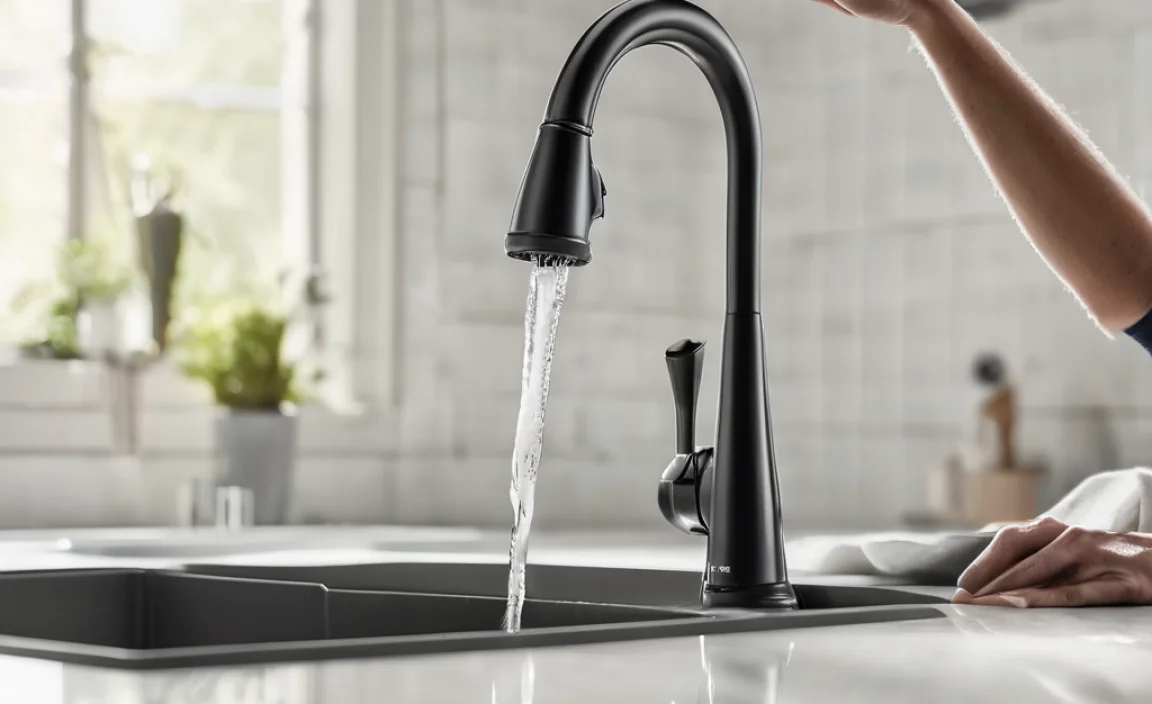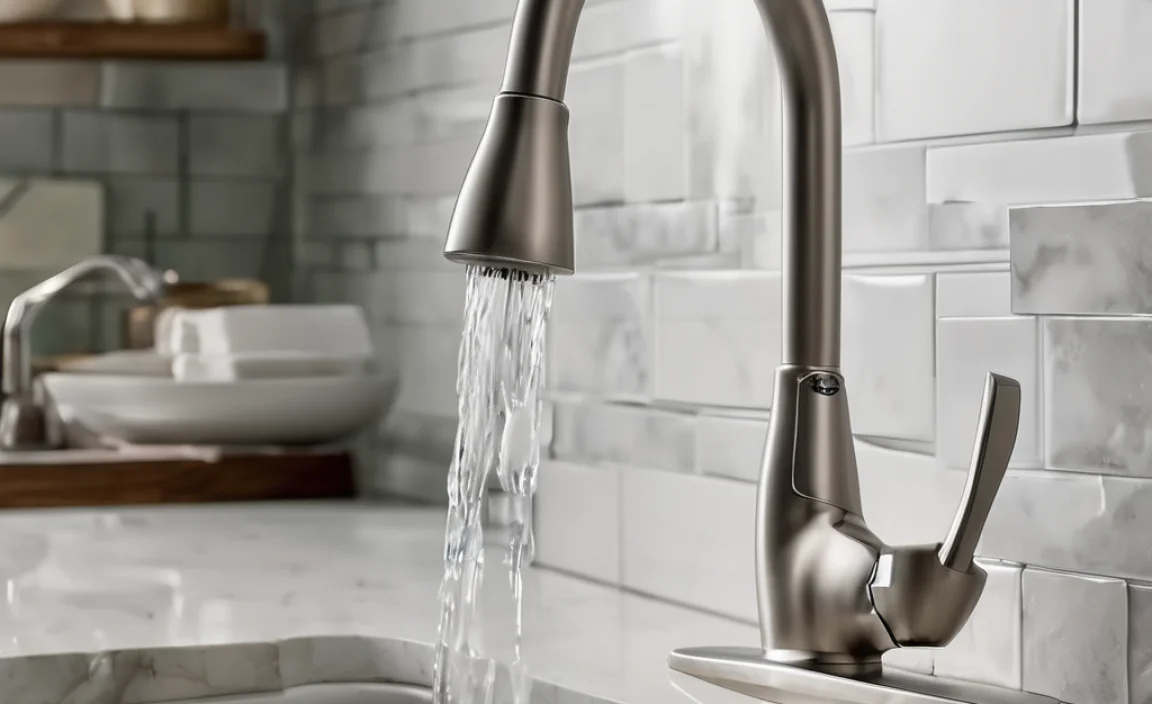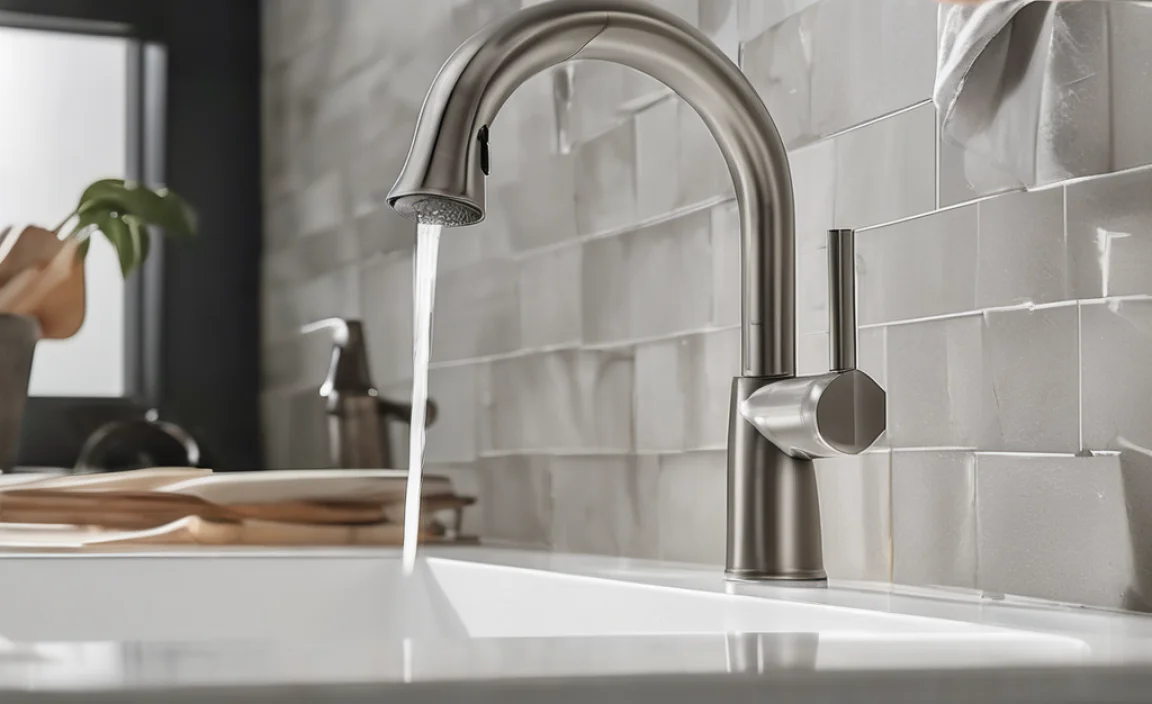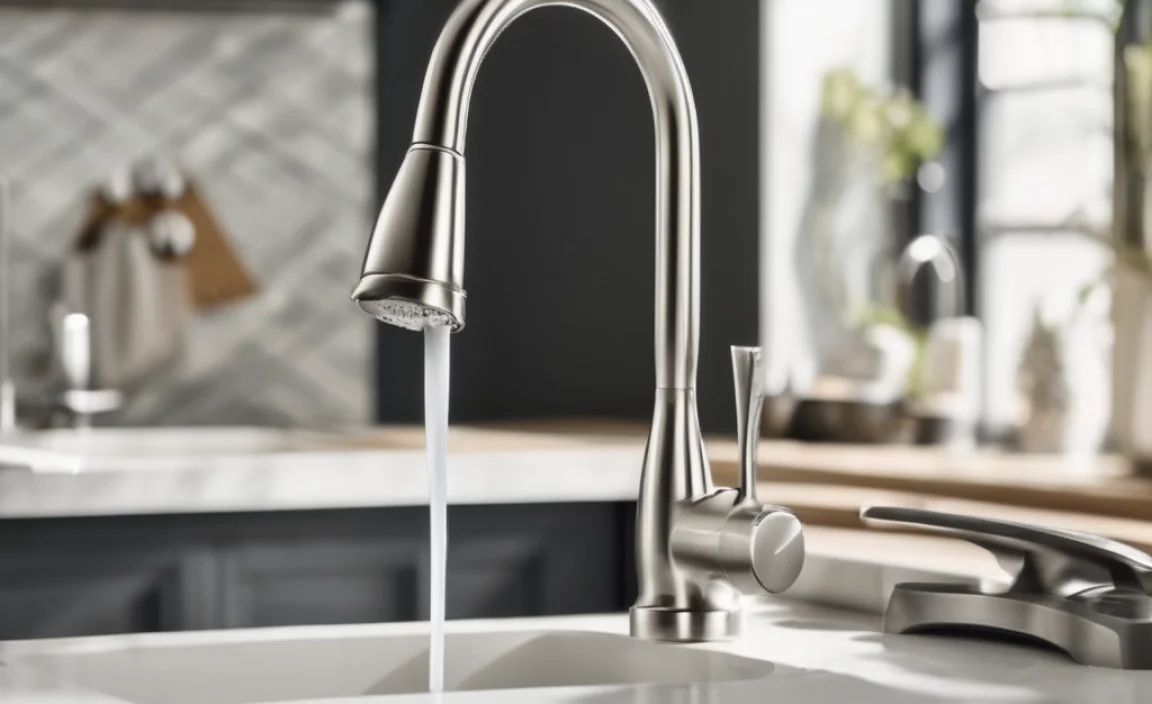Got a leaky Delta faucet? Don’t worry! Disassembling it is easier than you think. First, turn off the water supply. Then, remove the handle, loosen the set screw, and take off the cap and sleeve. Next, unscrew the retaining nut and pull out the valve cartridge. Now you can clean, repair, or replace the parts. You’ve got this!
Is your Delta faucet dripping, or does it have low water pressure? Many times, the issue isn’t a major plumbing problem. Often, it’s a simple fix like cleaning or replacing a few parts inside the faucet. But to get to those parts, you need to take the faucet apart.
Taking apart a faucet might sound scary, but don’t worry! This guide will show you how to disassemble a Delta faucet step-by-step. We’ll cover everything from turning off the water to removing the valve cartridge. By the end, you’ll be able to tackle this DIY project with confidence. Let’s get started!
Tools You’ll Need

Before you start, gather these tools. Having everything ready will make the job much easier.
- Adjustable Wrench: For loosening nuts and fittings.
- Screwdrivers: Both flathead and Phillips head, depending on your faucet model.
- Allen Wrench Set: For removing set screws.
- Penetrating Oil: To loosen stubborn parts.
- Plumber’s Grease: To lubricate parts during reassembly.
- Clean Cloths or Sponges: For cleaning parts.
- Basin Wrench: Helpful for tight spaces under the sink.
- Flashlight or Headlamp: To see clearly in dark areas.
- Safety Glasses: To protect your eyes.
- Gloves: To protect your hands.
- Small Container: To hold small parts.
Safety First!

Before you even think about touching the faucet, make sure you’ve taken these crucial safety steps:
- Turn Off the Water: Locate the shut-off valves under the sink. Turn them clockwise until they’re completely closed. If you don’t have shut-off valves, you’ll need to turn off the main water supply to your house.
- Protect Your Eyes: Wear safety glasses to prevent debris from getting in your eyes.
- Wear Gloves: Protect your hands from dirt and sharp edges.
- Read Instructions: Take a moment to read through these instructions before you start.
Step-by-Step Guide to Disassembling a Delta Faucet

Follow these steps to safely and effectively disassemble your Delta faucet.
Step 1: Shut Off the Water Supply
The most important step! Find the shut-off valves under your sink. They usually look like small oval handles or knobs. Turn them clockwise until they stop. If you don’t have these valves, go to your basement or utility room and turn off the main water supply to your house. You might want to let your family know so they don’t get surprised by no water.
Test the Water: Turn on the faucet briefly to make sure the water is completely off. If water still comes out, double-check that you’ve turned the correct valves all the way.
Step 2: Plug the Sink Drain
Plug the sink drain to prevent small parts from falling down the drain. Trust me, you don’t want to fish those out! A simple stopper or even a rag will do the trick.
Step 3: Remove the Handle
The way you remove the handle depends on the faucet model. Here are a few common types:
- Single Handle Faucets: Look for a set screw on the side of the handle. It’s usually a small Allen screw. Use an Allen wrench to loosen the screw. Once loose, you should be able to lift the handle straight off.
- Two-Handle Faucets: These might have decorative caps on the handles. Gently pry off the caps with a small flathead screwdriver. Underneath, you’ll find a screw. Unscrew it, and then you can remove the handle.
Step 4: Remove the Faucet Escutcheon or Base Plate
The escutcheon, or base plate, is the decorative plate that covers the faucet body. Here’s how to remove it:
- Single Handle Faucets: After removing the handle, you’ll usually see a threaded sleeve or collar. Unscrew this collar to release the escutcheon.
- Two-Handle Faucets: The escutcheon might be held in place by screws or a retaining nut. Look for any visible screws and remove them. If there are no screws, try gently twisting the escutcheon to see if it will unscrew.
If the escutcheon is stuck, try applying a little penetrating oil around the edges. Let it sit for a few minutes, then try again.
Step 5: Remove the Valve Cartridge
The valve cartridge controls the flow of water. Here’s how to get it out:
- Locate the Retaining Clip or Nut: The cartridge is held in place by a retaining clip or nut. It might be made of plastic or metal.
- Remove the Clip or Nut: If it’s a clip, use a small screwdriver or pliers to gently pry it out. If it’s a nut, use an adjustable wrench to loosen and remove it.
- Pull Out the Cartridge: Once the clip or nut is removed, you should be able to pull the cartridge straight out. It might be a little stiff, so try gently twisting it back and forth as you pull.
If the cartridge is really stuck, you can buy a cartridge puller tool at most hardware stores. This tool is designed to grip the cartridge and pull it out without damaging it.
Step 6: Inspect the Parts
Now that you’ve disassembled the faucet, take a close look at all the parts. Check for:
- Wear and Tear: Look for cracks, chips, or worn spots.
- Mineral Buildup: Hard water can leave mineral deposits that clog the faucet.
- O-Rings and Seals: Check if the O-rings and seals are cracked, dry, or damaged.
Replace any parts that look worn or damaged. You can usually find replacement parts at your local hardware store or online.
Step 7: Clean the Faucet Body and Parts
Use a soft cloth or sponge to clean the faucet body and parts. You can use a mild soap and water solution. For mineral buildup, try soaking the parts in white vinegar for a few hours, then scrub them with a soft brush. Rinse everything thoroughly with clean water before reassembling.
Step 8: Reassemble the Faucet
Now it’s time to put everything back together. Follow these steps in reverse order:
- Lubricate the Cartridge: Apply a thin layer of plumber’s grease to the O-rings and seals on the new or cleaned cartridge. This will help it slide in smoothly and create a good seal.
- Insert the Cartridge: Carefully insert the cartridge into the faucet body. Make sure it’s aligned correctly.
- Secure the Retaining Clip or Nut: Replace the retaining clip or nut to hold the cartridge in place. Tighten the nut with an adjustable wrench, but don’t overtighten.
- Replace the Escutcheon: Slide the escutcheon back into place and secure it with screws or a retaining nut.
- Reattach the Handle: Put the handle back on and tighten the set screw or screw.
Step 9: Turn the Water Back On
Slowly turn the water back on at the shut-off valves. Check for leaks around the faucet body and handle. If you see any leaks, turn off the water and double-check that all the parts are properly installed and tightened.
Step 10: Test the Faucet
Turn the faucet on and off to make sure it’s working properly. Check the water flow and temperature. If everything seems good, congratulations! You’ve successfully disassembled and reassembled your Delta faucet.
Troubleshooting Common Problems

Sometimes, things don’t go exactly as planned. Here are some common problems you might encounter, and how to fix them:
- Leaky Faucet: This is often caused by a worn-out cartridge or O-rings. Replace the cartridge and O-rings to solve the problem.
- Low Water Pressure: This could be due to mineral buildup in the faucet or aerator. Clean the faucet and aerator to improve water flow.
- Stiff Handle: This is usually caused by a lack of lubrication. Apply plumber’s grease to the cartridge and handle to make it move more smoothly.
- Handle Won’t Come Off: If the handle is stuck, try applying penetrating oil to the set screw or screw. Let it sit for a few minutes, then try again. You can also try gently tapping the handle with a rubber mallet to loosen it.
- Cartridge Won’t Come Out: If the cartridge is stuck, use a cartridge puller tool. This tool is designed to grip the cartridge and pull it out without damaging it.
Tips for Success

Here are a few extra tips to help you succeed:
- Take Pictures: Before you start disassembling the faucet, take pictures of each step. This will help you remember how everything goes back together.
- Keep Parts Organized: Use a small container or tray to keep all the small parts organized. This will prevent you from losing them.
- Don’t Force Anything: If something doesn’t seem to fit, don’t force it. Double-check that you have the correct parts and that everything is aligned properly.
- Read the Manual: If you have the faucet’s manual, read it before you start. It might have specific instructions for your model.
Understanding Delta Faucet Components
Familiarizing yourself with the different parts of a Delta faucet can make the disassembly and repair process much smoother. Here’s a breakdown of the key components:
| Component | Description | Function |
|---|---|---|
| Handle | The lever or knob used to control water flow and temperature. | Allows the user to turn the water on/off and adjust the temperature. |
| Set Screw | A small screw (usually an Allen screw) that secures the handle to the faucet stem. | Keeps the handle firmly attached to the faucet. |
| Escutcheon (Base Plate) | A decorative plate that covers the faucet body and mounting area. | Provides a finished look and covers the plumbing connections. |
| Valve Cartridge | A cylindrical component that controls the flow of water inside the faucet. | Regulates the mixing of hot and cold water and controls water flow. |
| Retaining Clip/Nut | A clip or nut that holds the valve cartridge in place. | Secures the cartridge within the faucet body. |
| O-Rings/Seals | Rubber rings that create a watertight seal between faucet components. | Prevents leaks and ensures proper water flow. |
| Aerator | A screen-like device at the tip of the faucet that mixes air with water. | Reduces water splashing and provides a smoother water flow. |
Delta Faucet Types and Disassembly Considerations
Delta offers various faucet styles, and while the general disassembly principles remain consistent, some nuances exist based on the faucet type. Here’s a look at common Delta faucet types and specific disassembly considerations:
| Faucet Type | Description | Disassembly Notes |
|---|---|---|
| Single Handle Faucet | Features one handle to control both water flow and temperature. | Typically uses a set screw to secure the handle. Easier to disassemble due to fewer parts. |
| Two Handle Faucet | Has separate hot and cold water handles. | Involves removing individual handle components, which may include decorative caps and screws. |
| Pull-Down Kitchen Faucet | Features a sprayer head that can be pulled out for flexible use. | Requires disconnecting the sprayer hose from the faucet body after handle and escutcheon removal. |
| Touch Faucet | Operates by touch, using electronic components. | Disassembly may involve disconnecting electronic connections. Requires extra caution and possibly consulting the user manual. |
| Wall-Mounted Faucet | Mounted directly to the wall, rather than the sink. | Disassembly can be more complex due to the integrated wall connection. May require access behind the wall. |
When to Call a Plumber
While disassembling a Delta faucet is a manageable DIY project, there are times when it’s best to call a professional plumber. Here are a few situations:
- You’re Not Comfortable: If you’re not comfortable working with plumbing, don’t force it. It’s better to call a plumber than to risk damaging your pipes or faucet.
- You Can’t Find the Problem: If you’ve disassembled the faucet and you still can’t figure out why it’s leaking or not working properly, a plumber can diagnose the issue.
- You Have Old or Corroded Pipes: If your pipes are old or corroded, you might damage them while trying to disassemble the faucet. A plumber can handle this situation safely.
- You’re Dealing with a Major Plumbing Problem: If the problem is more than just a leaky faucet, such as a burst pipe or a clogged drain, call a plumber right away.
FAQ: Disassembling a Delta Faucet
Here are some frequently asked questions to help you further understand how to disassemble a Delta faucet.
What’s the first thing I should do before disassembling my Delta faucet?
The very first thing is to shut off the water supply to the faucet. Locate the shut-off valves under the sink and turn them clockwise until they’re completely closed. If you don’t have shut-off valves, turn off the main water supply to your house.
Do I need special tools to disassemble a Delta faucet?
You’ll need a few basic tools, including an adjustable wrench, screwdrivers (both flathead and Phillips head), an Allen wrench set, penetrating oil, plumber’s grease, and clean cloths. A basin wrench can be helpful for tight spaces under the sink.
How do I remove the handle from my Delta faucet?
For single-handle faucets, look for a set screw on the side of the handle and loosen it with an Allen wrench. For two-handle faucets, pry off the decorative caps, unscrew the screw underneath, and then remove the handle.
What is the valve cartridge, and how do I remove it?
The valve cartridge controls the flow of water in the faucet. To remove it, first, take off the retaining clip or nut holding it in place. Then, gently pull the cartridge straight out. If it’s stuck, use a cartridge puller tool.
What should I do if I find mineral buildup inside my faucet?
Soak the affected parts in white vinegar for a few hours, then scrub them with a soft brush. Rinse everything thoroughly with clean water before reassembling.
How do I know if I need to replace the valve cartridge?
If your faucet is leaking or has low water pressure, the valve cartridge might be worn out. Inspect the cartridge for cracks, chips, or worn spots. If you see any damage, replace the cartridge.
Is it safe to disassemble a touch faucet?
Disassembling a touch faucet can be more complex due to the electronic components. Be extra cautious and disconnect any electronic connections before disassembling. If you’re not comfortable, it’s best to consult the user manual or call a professional.
Conclusion
Taking apart a Delta faucet might seem like a big job, but with the right tools and a step-by-step guide, it’s something you can definitely handle yourself. Remember to prioritize safety by turning off the water and protecting your eyes and hands. Take your time, keep the parts organized, and don’t be afraid to ask for help if you get stuck.
By following these instructions, you can save money on plumber fees and gain the satisfaction of fixing your faucet yourself. So go ahead, grab your tools, and give it a try. You might be surprised at how easy it is. Good luck!

